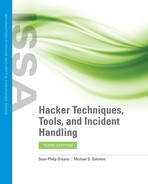Wireless Hacking Tools
There are many wireless hacking tools available to the attacker who wants to break into or discover wireless networks. Some common ones are listed below, followed by information on NetStumbler and inSSIDer:
Kismet
NetStumbler
Medieval Bluetooth Network Scanner
inSSIDer
CORE Impact
GFI LanGuard
coWPAtty
Wireshark
WiFi Pineapple
Ubertooth One (for Bluetooth)
NetStumbler
NetStumbler is one of the more common tools for locating 802.11 wireless networks. The software is designed to detect any 802.11a/b/g/n wireless network that your wireless network adapter supports. Note that NetStumbler is not currently being updated and does not officially support newer wireless protocols. The software can optionally use GPS location information to map out the location of the APs it detects. NetStumbler does not have many options and is simple to use (see FIGURE 8-1).

FIGURE 8-1
NetStumbler interface.
The inSSIDer Program
Although NetStumbler software offers a good amount of functionality, it is not the only product that can perform wireless network scanning. Another piece of software that can do the same thing is inSSIDer. According to MetaGeek, the makers of inSSIDer, features unique to inSSIDer include the following:
Can be used with multiple current versions of Microsoft Windows
Uses the Native Wi-Fi application programming interface (API) and current wireless network card
Detects and supports the latest 802.11 protocols
Can group by Media Access Control (MAC) address, SSID, channel, received signal strength indicator (RSSI), and “time last seen”
The inSSIDer tool can do the following:
Inspect your WLAN and surrounding networks to troubleshoot competing APs
Track the strength of received signals in dBm (a measurement of decibels) over time
Filter APs in an easy-to-use format
Highlight APs for areas with high Wi-Fi concentration
Export Wi-Fi and GPS data to a Keyhole Markup Language (KML) file to view in Google Earth
The inSSIDer interface is shown in FIGURE 8-2.

FIGURE 8-2
The inSSIDer interface.
Once a target has been identified and its identifying information noted, the attack can begin.
